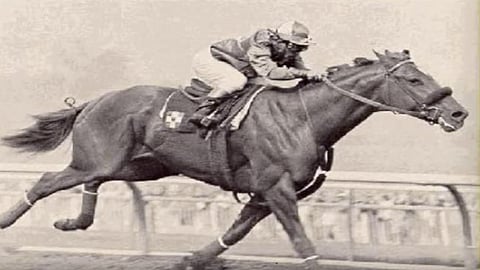Kentucky Derby Week: Garrity on how the new Derby points system has killed the Silky Sullivan effect
It's a thrilling sight, especially to a horse racing neophyte: a horse is plodding along, way behind the leaders, a million miles in last place. Then the horse starts moving past a few tired horses, then a few more, and then all of a sudden -- he's in contention! Passing horses around the far turn, the runner enters the stretch with a chance... and then he's near the front! He just might do it! This horse, as Trevor Denman might say, has come out of the clouds on the grandstand side!
While this scenario is pretty common in grass races, on dirt it is much, much rarer. Still, despite the rarity, there have been horses over the years who could do it: Zenyatta, certainly; Giacomo, who won the 2005 Kentucky Derby at 50-1; and we remember a Southern California horse from about 15 years ago called Choctaw Nation.
But to us, the horse who epitomizes this late-running equine archetype is Silky Sullivan. Silky was the beaten favorite in the 1958 Kentucky Derby, but his main claim to fame is winning races from way, way back, so far back that it defies belief: he once won a 6 1/2 furlong allowance race at Santa Anita after trailing the leader by 41 lengths (see below). Old Silky became so renowned a come-from-behinder that his name entered common usage to describe any comeback in sports. Bill Raftery even dropped his name in the broadcast of the NCAA basketball finals a few years ago – we felt like we were the only person watching who got the reference.
Once-a-year racing fans tend to love these deep closers, but grizzled handicappers, a much more cynical lot, tend to dismiss them, because most races on dirt are not won this way. When a horse comes from way back to win, it is usually an aberration, and usually is more of an indication of the pace of the race than the ability of the horses in it. One can go to the track every day for decades looking for the next Silky Sullivan, and one can never find him.
There has been one race, however, where this kind of race shape has been fairly common: the Kentucky Derby. It has happened in the Derby, much more frequently than in any other race, and it usually happens this way: the early fractions of the Kentucky Derby are so fast that they fry not only the front-runners, but the horses right behind them, and sometimes even the horses in the next flight too. The 2001 Kentucky Derby was a good example of this: after front-running Songandaprayer set the fastest-ever half-mile fraction in Kentucky Derby history (44.86 seconds), the speed horses all collapsed, and Monarchos, who was something like 15 lengths behind the pacesetters, rallied down the stretch to win the race in 1:59 4/5, becoming the first horse since Secretariat to win the race with a final time under two minutes.
We will call this phenomenon the Silky Sullivan Effect.
There are several reasons for it: These are young horses, and going into the Derby none of them has run a mile and quarter before; the ninth and tenth furlongs are uncharted territory. Another reason is the way the prep races are run, and the prep races are won: races up to a mile, and even up to 9 furlongs, are typically dominated by horses with abundant early speed.
But the biggest reason for the Silky Sullivan Effect is the composition of the field itself: Until 2013, graded stakes earnings were used to determine which horses got in, which meant that a dollar in purse money in a 5-furlong juvenile race in July was worth just as much as a dollar in purse money in a major prep race like the Wood Memorial or the Santa Anita Derby. Thus a typical Kentucky Derby field would feature a number of very fast horses who had no hope of staying the 10 furlongs: Songandaprayer in the 2001 Derby is a good example of this, as after setting that ridiculously fast pace, he faded badly and finished 15th.
But in 2013, the eligibility conditions of the Kentucky Derby were changed. Graded stakes earnings were out, and a points system was in. The point value of races grew as the Derby got closer, which is only logical: a horse winning a major prep race three weeks before the Derby, like the Arkansas Derby, should absolutely get more credit than a horse who wins a slots-fueled sprint in December.
This change was little-noticed at the time, but it has had a huge impact on how the Kentucky Derby has been run. And it has had a huge impact on the results: since 2013, the race is run much more like a "normal" horse race than it was under the old system. The Silky Sullivan Effect has virtually disappeared. And this has created a sea change in how the Derby must be handicapped. Since 2013, the odds of the winning horses have been 5/2, 9/2, 2-1, 5/2, 5/2, and 5-1. In the nine years before that, there were winners at 15-1, 20-1, and two winners at 50-1. The elimination of the Silky Sullivan Effect has turned the Kentucky Derby into a much more formful race.
Tomorrow, we'll go into detail about how this change impacts the handicapping of the Kentucky Derby, and how it should impact a serious handicapper's effort to break down the field.

